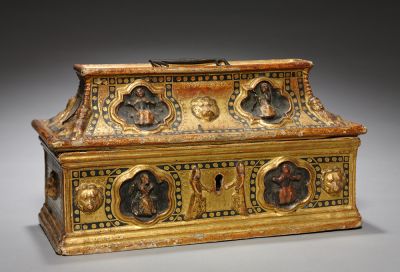ll matrimonio nel Rinascimento non era un fatto privato o una libera scelta basata sul reciproco affetto tra due giovani. Al contrario, esso rappresentava spesso un ‘contratto’ stipulato tra famiglie di alto rango che non teneva conto dell’amore. Il passaggio da fanciulla posta sotto la tutela del padre a sposa assoggettata al marito richiedeva elaborate cerimonie pubbliche per comunicare all’intera cittadinanza il potere politico ed economico acquisito dai due casati attraverso l’alleanza matrimoniale. Una serie di oggetti preziosi venivano offerti dal futuro marito e dal suo parentado alla sposa in occasione del fidanzamento e delle nozze. Tra i più consueti c’era il cofanetto, una scatola di piccole dimensioni realizzata con materiali preziosi, abbellita da elaborate decorazioni e contenente gioielli o ad altri regali. Il Museo di Arte di Cleveland annovera all’interno della propria collezione un raro cofanetto di legno in perfetto stato di conservazione, probabilmente realizzato a Siena intorno alla fine del 1300.
In Renaissance Italy, betrothal and marriage were formalized less by written documents, as in our modern world, than by eyewitness testimony of the rituals that accompanied the nuptial process. This included the continued presence, in the household, of objects exchanged during these various steps towards marriage. At all levels of the social ladder, betrothal and marriage entailed a series of symbolic items exchanged as gifts. The offering and acceptance of such gifts were considered integral parts of the marriage process and could even be used as evidence in legal disputes.
In the process of courtship, small, symbolic gifts were exchanged between aspiring couples who often marked their first, tentative steps towards betrothal through the offering and acceptance of a number of objects: ribbons, gloves, handkerchiefs, rings, coins, and locks of hair. All of which were invested, by custom, with deep meaning. In the propertied classes, family strategies allowed the young less leeway in the choice of a marriage partner. It was the political and economic interests represented by the merging of two families that tended to prevail. Those who made up the propertied classes of Renaissance Italy were well-to-do artisans, merchants, notaries, lawyers, doctors, and bankers who achieved high social status through their wealth and influence. Once the betrothal process was set in motion, as much as a year could pass until the wedding took place and the bride was transferred to her new home.
The next series of steps towards marriage entailed not only an increasing number of events, but also a crescendo of ritual gestures and gifts. The betrothal feast was held in the court of the young man, who now would delegate one of his male relatives or friends to bring his intended a small box or casket called a cofanetto filled with jewels and other presents. These small caskets were often made of precious materials and elaborately decorated. Inside might be any number of objects traditionally given to the future bride such as a brooch set with precious stones, a jeweled pendant, a gold chain, a silk girdle (belt) studded with silver, or an ivory needle case. Many of these gifts would be inscribed with the initials of the new couple, with their family coats of arms or with amorous mottos. Some of the earliest portraits of young women depict them adorned by such jewels or surrounded by objects that most probably were betrothal gifts.
Such an object is preserved in the galleries of the Cleveland Museum of Art. It is a small wood casket, about 16 inches in length, beautifully gilded and painted. It was likely made in Siena towards the end of the 1300s. The casket has a keyhole lock for security and a handle on the lid for portability. Gesso paste, known as pastiglia, was used to create raised ornamental figures in relief representing the virtues - female personifications intended to convey abstract ideas like chastity or fidelity. Representations of such moralized concepts concerning a woman’s relationship to a man are common on betrothal caskets or marriage chests during the Renaissance. The Cleveland casket is a beautiful object that surely would have been intended to be seen in the home. It is not known for whom it was made. However, this casket is one of only a few of its kind to survive in such a fine state of preservation.
Small coffanetti were later accompanied by much larger wedding chests also known as cassoni. These larger pieces of furniture could measure from 4 to 6 feet in length and were generally used for the storage of clothing. Like their smaller counterparts, cassoni were extensively decorated by carving, painting or gilding and represented a gift from husband to wife on their wedding day. These large chests were regarded as one of the most precious pieces of furniture in the Renaissance home. Cassoni were often displayed during the procession that accompanied the bride to her new home and were sometimes decorated with the family coats of arms or pictures of legendary heroes or stories intended to underscore the strength of love. Examples of these larger wedding chests may also be seen in the Cleveland Museum of Art.
Our smaller coffanetto was once someone’s treasure. Though it remains a handsome decorative arts object, its meaning is deeper and more personal. For whom was this wonderful object made? Who was her husband? What sort of betrothal presents did it contain? History often leaves us wanting more. What we do know about this little casket is that it was found in a convent in Siena during the early 20th century. How did it come to be there? During the Middle Ages and the Renaissance, widows often retired to convents as a place to spend their final years in prayer, peace and contemplation. Is it possible that a widow brought her betrothal casket to the convent with her, a final link to her lost love and a tangible memory of her youth? Some things we must leave to our imagination.



